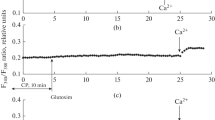Abstract
Using Fura-2AM, a fluorescent Ca2+ indicator, we have shown for the first time that sigma-1 receptor antagonist - neuroleptic chlorpromazine - significantly inhibits the store-dependent Ca2+ entry induced by immunomodulators glutoxim as well as molixan and endoplasmic reticulum Са2+-ATPase inhi-bitors thapsigargin and cyclopiazonic acid in rat peritoneal macrophages. The results suggest the involvement of sigma-1 receptors in the regulation of store-dependent Ca2+ entry in macrophages.




Similar content being viewed by others
REFERENCES
J. W. Putney, Cell Calcium 11, 611 (1990).
J. W. Putney, Adv. Exp. Med. Biol. 981, 205 (2017).
J. W. Putney, Neurochem. Res. 36, 1157 (2011).
M. Prakriya and R. S. Lewis, Physiol. Rev. 95, 1383 (2015).
L. Vaca, Cell Calcium 47, 199 (2010).
C. Moreno and L. Vaca, in Store-operated Ca 2+ Entry (SOCE) Pathways (Springer, Wien, 2012), pp. 93–113.
R. M. Nwokonko, X. Cai, N. A. Loktionova, et al., Adv. Exp. Med. Biol. 993, 83 (2017).
N. T. Nguyen, W. Han, W.-M. Cao, et al., Compr. Physiol. 8, 981 (2018).
V. Lunz, C. Romanin, and I. Frischauf, Cell Calcium 77, 29 (2019).
C. G. Rousseaux and S. F. Greene, J. Recept. Signal Transduct. 36, 327 (2016).
T.-P. Su, T. Hayashi, T. Maurice, et al., Trends Pharmacol. Sci. 31, 557 (2010).
T. Hayashi and T.-P. Su, Cell 131, 596 (2007).
E. J. Cobos, J. M. Entrena, F. R. Nieto, et al., Curr. Neuropharmacol. 6, 344 (2008).
Z. I. Krutetskaya, L. S. Milenina, A. A. Naumova, et al., Dokl. Biochem. Biophys. 472 (1), 81 (2017).
Z. I. Krutetskaya, L. S. Milenina, A. A. Naumova, et al., Dokl. Biochem. Biophys. 480 (1), 152 (2018).
Y. Itzhak, M. Ruhland, and H. Krahling, Neuropharmacology 29, 181 (1990).
R. E. Conrad, in Manual of Macrophages Methodology (Marcell Dekker, New York, 1981), pp. 5–11.
C. Randriamampita and A. Trautmann, Cell Biol. 105, 761 (1987).
R. A. Monahan, H. F. Dvorak, and A. M. Dvorak, Blood 58, 1089 (1981).
J. I. E. Bruce and A. C. Elliott, Br. J. Physiol. 131,761 (2000).
Q. Xie, Y. Zhang, C. Zhai, et al., J. Biol. Chem. 277, 16559 (2002).
G. Grynkiewicz, M. Poenie, and R. Y. Tsien, J. Biol. Chem. 260, 3440 (1985).
J. L. Harper and J. W. Daly, Drug Dev. Res. 47, 107 (1999).
S.-Y. Choi, Y.-H. Kim, Y.-K. Lee, et al., Br. J. Pharmacol. 132, 411 (2001).
M. S. Amer, L. McKeown, S. Tumova, et al., Br. J. Pharmacol. 168, 1445 (2013).
N. C. McNaughton, P.J. Green, and A. D. Randall, Acta Physiol. Scand. 173, 401 (2001).
Z. I. Krutetskaya, L.S. Milenina, A. A. Naumova, et al., Dokl. Biochem. Biophys. 481 (1), 222 (2018).
S. Srivats, D. Balasuriya, M. Pasche, et al., J. Cell Biol. 213, 65 (2016).
Funding
This work was carried out within the framework of the research program of the Department of Biophysics of St. Petersburg State University and the Department of Clinical Biochemistry and Laboratory Diagnostics of the Military Medical Academy named after S.M. Kirov (St. Petersburg), as well as the Contract for the implementation of research works, project no. 28-12-38.
Author information
Authors and Affiliations
Corresponding authors
Ethics declarations
CONFLICT OF INTEREST
The authors declare that there is no conflict of interest.
COMPLIANCE WITH ETHICAL STANDARDS
The animals and all manipulations with them were carried out in accordance with the regulations and requirements of the Order of Ministry of Health of the Russian Federation No. 267 of 19.06.03 “On approval of rules for laboratory practice in the Russian Federation.”
Additional information
Translated by E. Puchkov
Abbreviation: [Ca2+]i, intracellular concentration of Ca2+.
Rights and permissions
About this article
Cite this article
Milenina, L.S., Krutetskaya, Z.I., Antonov, V.G. et al. The Sigma-1 Receptor Ligand Chlorpromazine Attenuates Store-Dependent Ca2+ Entry in Peritoneal Macrophages. BIOPHYSICS 66, 77–83 (2021). https://doi.org/10.1134/S0006350921010115
Received:
Revised:
Accepted:
Published:
Issue Date:
DOI: https://doi.org/10.1134/S0006350921010115




